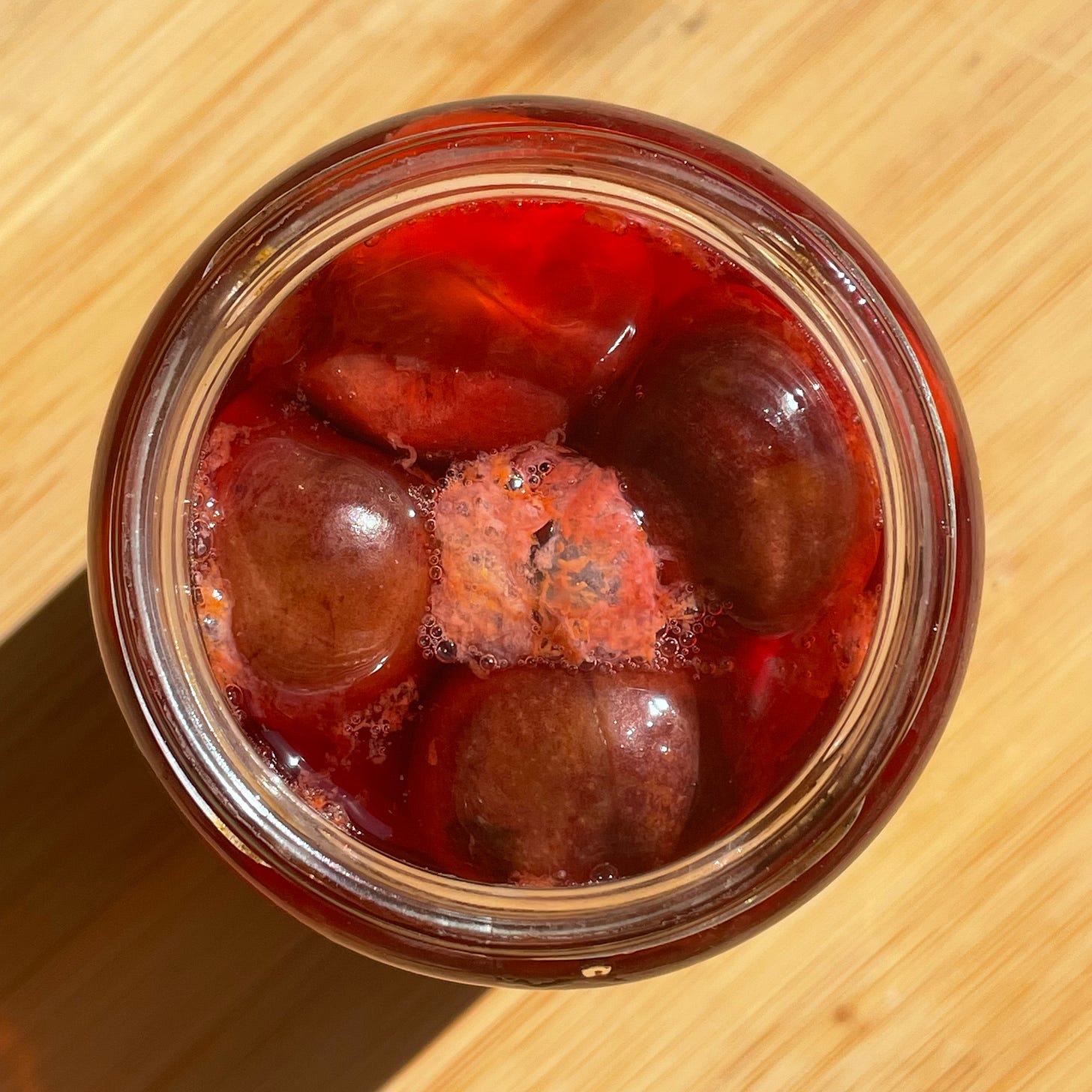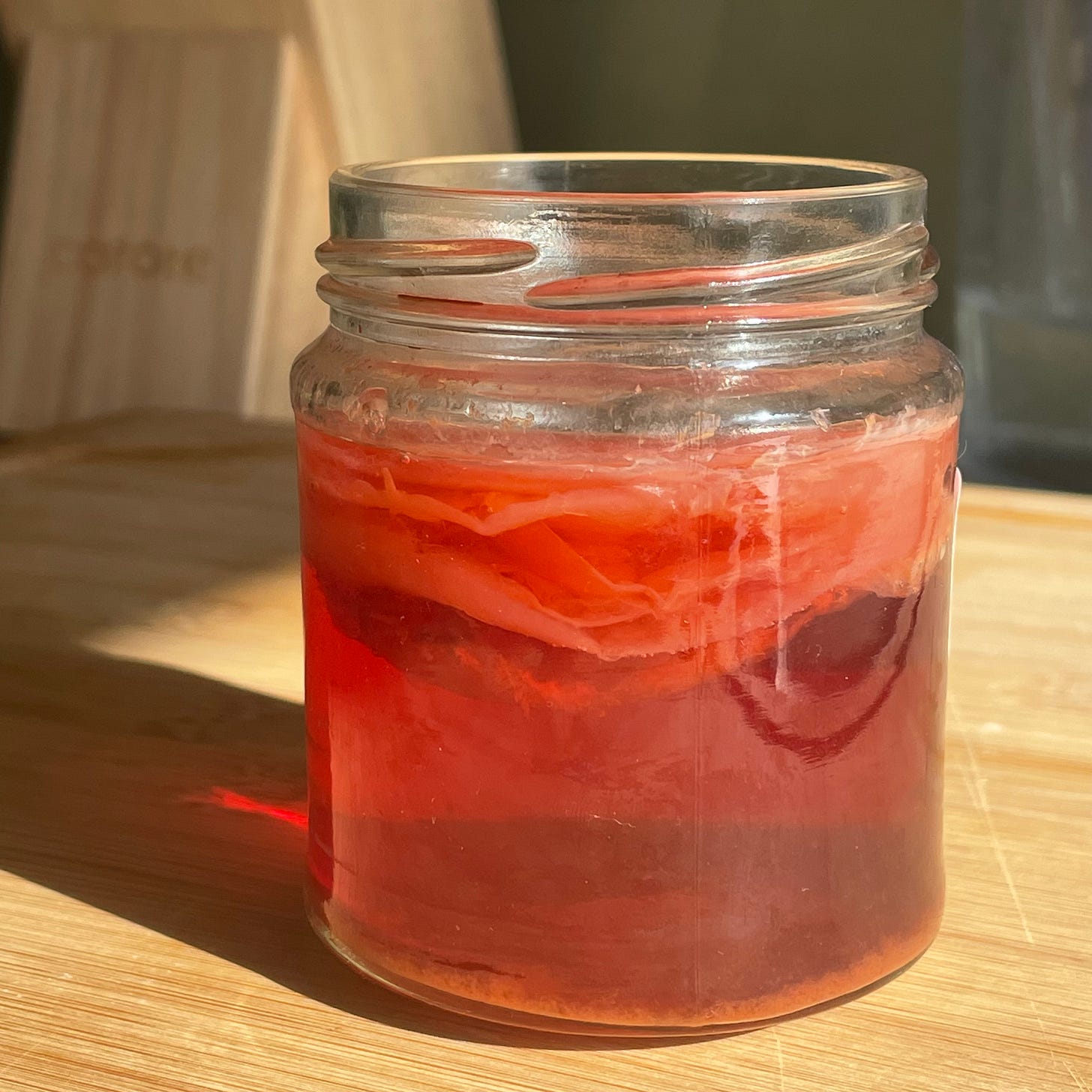Making cherry kombucha-vinegar from a surprise SCOBY
And what the heck is the difference between a kombucha scoby and a vinegar mother, anyway? Let's break it down.
A couple weeks back I published a recipe for a gorgeous clementine almond cake with some kombucha pickled cherries - the cherries were a particularly special addition, and pickled beautifully after just one day soaking in a super-sour rooibos kombucha.
And after about 3 days, I started to notice some white, bubbly growth amongst those cherries. It definitely wasn’t kahm yeast - that harmless but flavour-throwing yeast which especially loves sugary mediums - as this film was thicker and looked rather rubbery. Over the next few days it grew, and after about a week the rubbery film covered the entire surface: a new kombucha scoby had formed.
So what happened here? Well, it’s a fairly simple and natural process - my kombucha was both unstrained and raw, meaning that some of the sediment containing live microbial cultures made its way into the cherry mix. The cultures fed off of the fresh sugars naturally present in the cherries, and the rest is history.
After a week I strained out my cherries, but kept the scoby in with the liquid. That liquid continued to grow, and over the course of 4 weeks is now over an inch thick, with several layers, and is colored a pale, orange-y red. The scent is now deeply funky, the flavour pretty sour - all in all, it’s ageing like a vinegar.
There’s debate over whether kombucha scobys and vinegar mothers are, in fact, the very same thing. They sure look similar, alien-esque pellicles of microbial cultures; and they perform similar functions too, feeding off the medium and producing acids, resulting in fermentation.
The difference lies in the medium that they live in, and subsequently the predominant cultures that form to live off of the food that medium provides.
Vinegar mothers form on liquids that contain alcohol, like fruit wines, beers, or ciders. They contain acetic acid bacteria cultures, which convert the alcohols into acetic acid (also the scientific name for vinegar!). The ideal alcohol content for a vinegar mother to healthily grow is between 5-10%, so anything with a higher proof should be diluted!
Kombucha scobys, meanwhile, are adapted to sweet tea liquids. That means that they need to contain microorganisms which will feed off that sugar, like yeasts which convert sugars into alcohol, and lactic acid bacteria which convert sugars into lactic acid. On top of this, kombucha scobys also contain acetic acid bacterial cultures, to turn the alcohol produced by the yeast into acetic acid, or vinegar. A kombucha scoby is thus a more complex mix of microorganisms, which allows multiple fermentation processes to happen all at once, ultimately resulting in an acidic medium. And as the medium grows more acidic, yeasts die off…and if it gets REALLY acidic, lactic acid bacteria will die off too, leaving only the acetic acid cultures to feed off of alcohol.
Both require exposure to oxygen in order to ferment because both contain acetic acid and kombucha contains yeasts, too (contrary to purely lactic acid fermentation, which needs an anaerobic environment!).
I’m calling this recipe a cherry kombucha-vinegar, just to distinguish that this vinegar-adjacent liquid is made from a kombucha base, but it can be used interchangeably with any light vinegar.
One thing to note is that there will be a limit to how much you can acidify your kombucha vinegar, and it’ll never get to the vinegary level of a true vinegar. This is because acetic acid bacteria need to have sufficient alcohol to produce acetic acid, and when you’re starting with a kombucha that hasn’t gone through a full alcohol-producing process, there’ll be limited amounts of alcohol to convert. Add to that the fact that yeasts (whose role is to produce those alcohols) die off at low levels of acidity anyway, and you can understand how your kombucha scoby will run out of food to survive pretty quickly. Instead, your kombucha vinegar will be composed of a combination of lactic acid and acetic acid (rather than the pure acetic acid which happens in vinegar production).
Make sense? Alright, let’s get into the recipe! I’m thinking that I’ll use this cherry kombucha-vinegar to make a homemade non-alcoholic herbal shrubs, inspired by the delicious Botivo. Stay tuned for that recipe!
Happy fermenting!
Fruit kombucha-vinegar
Ingredients:
Fruit of choice
Mature, live kombucha with sediment
Instructions:
Combine your fruit and mature kombucha in a jar, covering the fruit with the liquid.
Let the fruit sit for 1 week, checking every day to make sure no moulds are growing. You should see a scoby developing little by little.
Strain out the fruit (and use it to accompany cake, pork chops, or to top your breakfast yoghurt - the possibilities are endless!) but keep the liquid and the growing scoby.
Let the scoby feed off the remaining sugars and developing alcohols in the liquid for about a month.
Remove the scoby, and use the vinegar as you would a red wine vinegar - in marinades, vinaigrettes, or add some honey and sparkling water for a homemade shrub!
Learn to ferment with me! Upcoming Courses:
September 15th - 11-2pm at the Hornbeam Cafe, Walthamstow
September 22nd - 11-2pm at the Hornbeam Cafe, Walthamstow








My current counter space constraint currently has my kombucha efforts on pause, otherwise I'd be making this! It sounds so nice and like a really fun project. Perhaps I'll try to find someone giving away a bit of kombucha locally and try to do this in a small batch :)